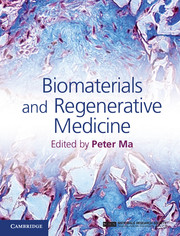Book contents
- Frontmatter
- Contents
- List of contributors
- Preface
- Part I Introduction to stem cells and regenerative medicine
- Part II Porous scaffolds for regenerative medicine
- Part III Hydrogel scaffolds for regenerative medicine
- 14 Polysaccharide hydrogels for regenerative medicine applications
- 15 Functionalized poly(ethylene glycol) hydrogels for controlling stem cell fate
- 16 Fumarate-based hydrogels in regenerative medicine applications
- 17 Hydrogel scaffolds for regenerative medicine
- 18 Microfabricated gels for tissue engineering
- 19 Organ printing
- Part IV Biological factor delivery
- Part V Animal models and clinical applications
- Index
- References
17 - Hydrogel scaffolds for regenerative medicine
from Part III - Hydrogel scaffolds for regenerative medicine
Published online by Cambridge University Press: 05 February 2015
- Frontmatter
- Contents
- List of contributors
- Preface
- Part I Introduction to stem cells and regenerative medicine
- Part II Porous scaffolds for regenerative medicine
- Part III Hydrogel scaffolds for regenerative medicine
- 14 Polysaccharide hydrogels for regenerative medicine applications
- 15 Functionalized poly(ethylene glycol) hydrogels for controlling stem cell fate
- 16 Fumarate-based hydrogels in regenerative medicine applications
- 17 Hydrogel scaffolds for regenerative medicine
- 18 Microfabricated gels for tissue engineering
- 19 Organ printing
- Part IV Biological factor delivery
- Part V Animal models and clinical applications
- Index
- References
Summary
Introduction
Some strategies in tissue engineering and regenerative medicine (TERM) rely on the use of an appropriate biomaterial to guide and foster tissue repair and regeneration. Collagen-based materials are perhaps the most widely investigated of these biomaterials because collagen is the primary structural protein responsible for tissue integrity in most tissues [1]. Collagen gels offer several advantages as a scaffolding material, including the ability to deliver a homogeneous distribution of entrapped cells into a specific geometry and excellent biocompatibility and transport properties [2]. However, collagen does have some disadvantages, including suppression of cell proliferation and protein synthesis [3, 4], issues that can limit the quality of the engineered tissue produced.
An alternative biopolymer that shares similar properties to collagen is fibrin. Fibrin is a natural biopolymer involved in the wound-healing process, and it forms the provisional matrix of a clot. It rapidly polymerizes to form a biocompatible and biodegradable fibrous scaffold that promotes cell proliferation and ECM synthesis. Another attractive property of fibrin is that its precursor (fibrinogen) can be extracted from the patient’s blood, making it an autologous material. In this chapter we will review the properties of fibrin and fibrin-based engineered tissues and how these materials are being incorporated into TERM technologies.
- Type
- Chapter
- Information
- Biomaterials and Regenerative Medicine , pp. 295 - 316Publisher: Cambridge University PressPrint publication year: 2014
References
- 5
- Cited by

